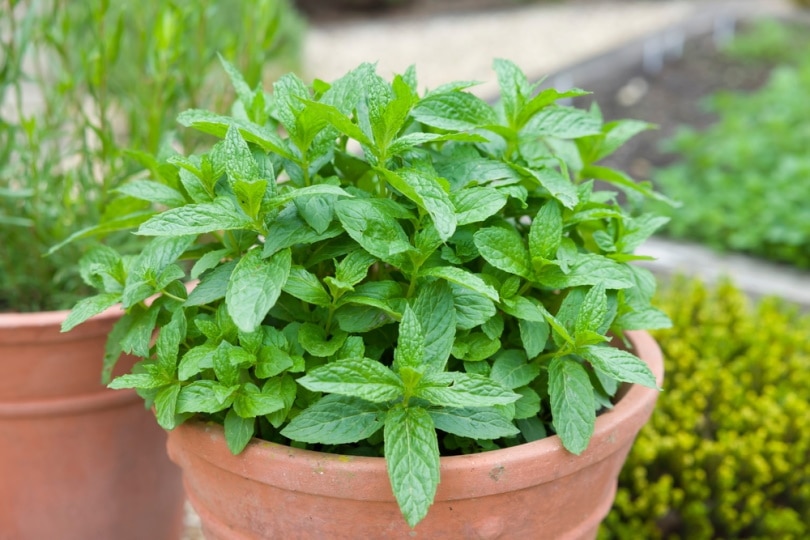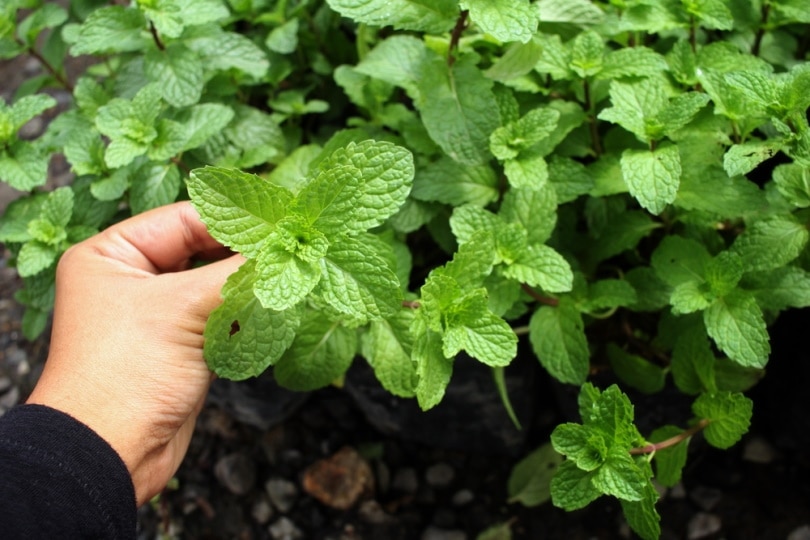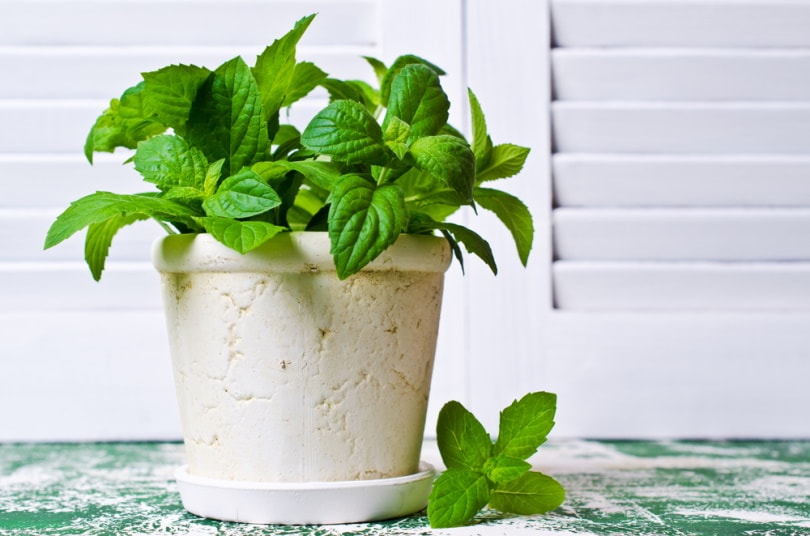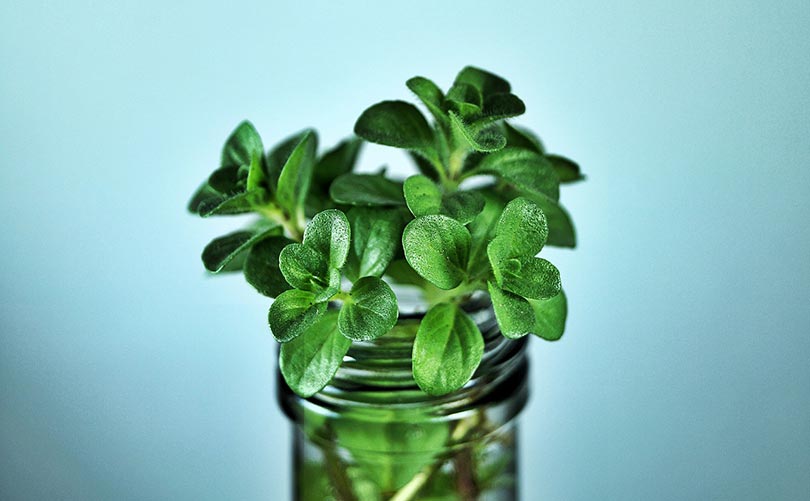How Much & How Often to Water Mint? Factors, Signs & FAQ
-
Visnja Radosavljevic
- Last updated:

People across the world grow mint plants so that they can harvest fresh mint throughout the year. If you are growing mint or want to grow it, you need to provide it with the proper care, which includes regular watering.
You may be wondering how much and how often to water mint, and we’re here to provide you with the needed information to grow a successful mint plant. Keep reading to learn more about mint watering and possible obstacles you might face along the way.
Water Requirements of Mint Plants
Mint is not a high-maintenance plant; it can grow in different light conditions and various climates and soils. However, when it comes to the watering requirements of mint plants, mint requires that the soil is constantly moist but not overwatered.
Depending on the environmental conditions in your surroundings, your mint plant will need around 1 to 2 inches of water per week. Outdoor plants commonly need less water, relying on environmental changes and rain to provide them with additional water.
Mints like soil that’s wet enough but not soggy, so you should track the time it takes for your plant to dry out. That way, you can find a specific watering schedule that works for your needs.

How to Water Mint
Mint is a relatively drought-tolerant plant, and it would be able to survive even if you occasionally forget to water it. However, it loves water, and when watering mint, it’s best to soak the plant well and wait for the top inches of soil to dry out before the next watering.
Typically, you need to water mint plants weekly, although they might need more watering if you’re growing them in pots. The watering frequency will also depend on various factors that might increase or decrease the need for watering.
- Sun: Most mint species need full sun to thrive. However, although they are drought-tolerant, your mint plants could suffer from not receiving enough water in the hot summer months. That’s why you should water mint grown in the full sun more frequently than when planted indoors or in the shade.
- Soil: The soil type in which your mint plant is growing will also impact the watering requirements for your plant. You should plant mint in well-draining soil that has good water retention qualities. Although it can grow in all soil types, we suggest that your soil has a pH between 6 and 7.5. You can also add mulch over the soil to allow it to retain water better than usual. You can perform a soil test to determine if your plant needs watering or not. All you need to do is stick your finger into the soil to check its moisture. If the top two inches of the soil are dry, it’s a sign that it’s time to water your plant.
- Weather: Generally, you need to water your mint much less during spring than in summer. If there are more rainy days, be careful to avoid overwatering your mint plant. The plant will need less watering during winter, typically around once weekly.
- Placement: If you plant your mint plants close together, they’ll require more water because they compete for water due to the small spacing.
How Often Should You Water Mint?
You should water mint frequently enough to keep the water moist without overwatering the plant. It’s best to perform the finger test to verify if the soil needs more water or not.
There’s no general watering rule that works for everyone because the environmental and growing conditions dictate the water amount your mint plant needs. You need to consider the climate, soil type, and other factors like placement and the weather. Also, consider the temperature in your area and the number of direct sun exposure your plant has.
There will also be a difference in watering needs for indoor and outdoor plants.

Indoors
When growing your mint indoors, the plant will commonly need more frequent waterings than the one grown outdoors. That’s because outdoor plants also get water from rain, while indoor plants rely on you as the only water source.
Typically, if you grow mint in well-draining soil, you must water it once or twice weekly. Check the soil moisture every once in a while to see if you need to change your watering schedule.
Another factor that will affect the watering frequency of indoor mint plants is the plant’s pot. That includes the type of pot and its size, as smaller pots typically dry out quicker in hot environments. That’s why mint plants in smaller pots need more frequent watering.
Outdoors
When you have an outdoor mint plant, you must consider the weather, sun, and temperature. During hot seasons, you will need to water your mint plant a couple of times a day. However, that will reduce to once a week during the cooler months.
Always check the soil moisture to determine if you need to add more or less water.
How Often Should You Water Mint Seeds and Seedlings?
Mint seeds need between 10 and 15 days to germinate. During that period, you should keep the water moist, typically by watering it once every 2 days, although this can vary slightly depending on the temperature inside your environment. If you live in hotter climates or have more sunny days, your mint seeds might need watering daily.
Avoid overwatering by checking the soil moisture, as too much water could take away the oxygen from your plant. Without it, the plant wouldn’t be able to form roots and grow.
When it comes to watering mint seedlings, the young plants need more water to promote their early growth. If you place your mint seedlings close together, they might need to “fight” for water, requiring you to water the plant more frequently.
Try to water the plant in the early morning, and if needed, check the soil throughout the day if it’s hot outside.
Possible Issues When Watering Mint
When watering mint, it’s easy to make a mistake and cause possible issues with your plant. The most common problems connected with watering mint are underwatering and overwatering. You need to know how to recognize the signs signifying these issues to resolve them promptly. Otherwise, they could lead to your plant dying.
Signs of Overwatering Mint
- Mushy soil
- Root rot
- Droopy plant and leaves
- Yellow and brown leaves
- Mold
The first sign of overwatering is that your plant and its leaves will become droopy. With time, the leaves will turn yellow while slowly starting to brown. If there’s too much water, the soil will be mushy, as it won’t get a chance to dry out.
- Place the plant in a location with full sun
- Allow the topsoil to dry
- Repot your plant into a new pot
- Remove dead parts on the plant
To prevent overwatering, always water the plant once the first couple of inches of the soil are dry. Also, provide proper drainage in the pot, and strive to provide your mint plant with at least 6 hours of full sun exposure.

Signs of Underwatering Mint
- Dry and scratchy soil
- Yellow and brown leaves
- Plant dying
If your mint plant is underwatered, there are still chances you can help your plant. You should water it promptly while avoiding adding too much water at a time. Instead, try to water the mint with one glass of water and allow the plant to soak it before the next pour. Repeat this until your plant gets back to normal.
To prevent underwatering, water your mint every time you notice the top few inches of the soil are dry. As long as you water it regularly, you shouldn’t have any issues with underwatering.
Final Thoughts
Mint is undemanding, and even beginner gardeners can grow this plant. While it needs full sun to prosper, it also needs enough water. Young seedlings will need the most water to thrive. Older plants need watering when the topsoil dries out, which happens more frequently indoors.
If you’re in doubt about how frequently you need to water your mint plant, perform the finger test to see if the soil is moist enough or not.
- “How to Water Mint Plants”
- “Watering mint”
- “How Many Times a Day Does a Mint Plant Need to Be Watered?”
- “How Often to Water Mint? — Question Solved”
- “How Much Water Does Mint Need”
- “How Often To Water Mint Plants”
- “How to Tell if Mint Is Overwatered (And How to Save It)”
- “How Often Should I Water Mint? | Indoors vs. Outdoors”
- “HOW TO WATER MINT – MINT WATERING GUIDE”
Featured Image Credit: Paul Maguire, Shutterstock
Contents
